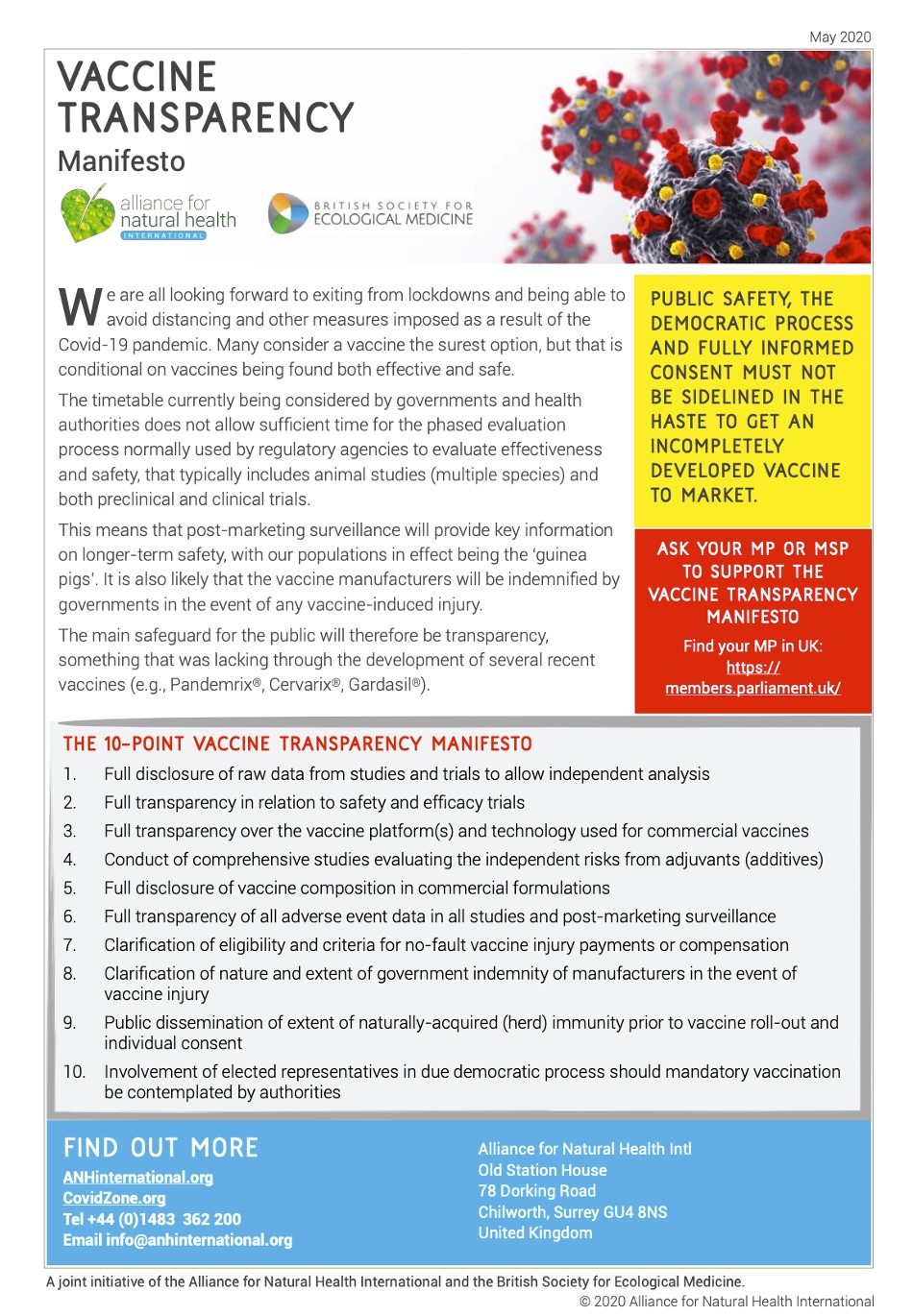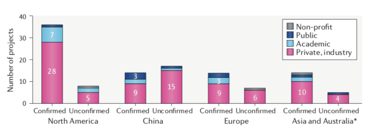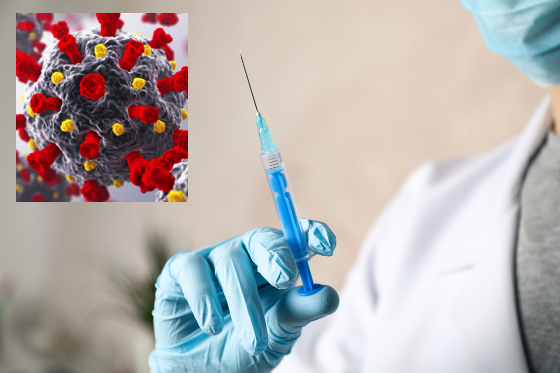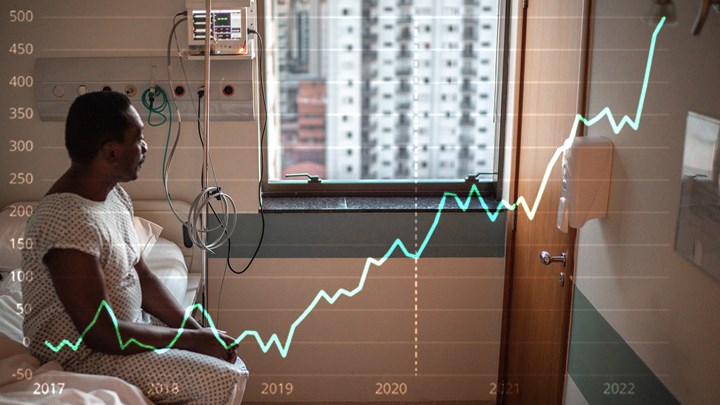We know many of our readers and supporters are as keen as we are to see what we term ‘vaccine transparency.’ We know this because we witnessed unprecedented traffic on our website and sharing of posts and videos after we sent an open letter to the UK Health Secretary, Matt Hancock MP, on 20th April calling for a new public narrative around vaccines based in transparency. In our view, we need as a society to break through the taboo surrounding the mere mention of vaccines if we’re to have confidence over the safety and effectiveness of the new vaccines under development for Covid-19. We also need transparency if we’re to ensure properly informed consent – this being a frequently overlooked legal requirement in many countries.
It’s both frustrating and unsurprising to have to tell you that to-date there’s been a resounding silence from Mr Hancock’s office. But we’re now moving to sending weekly reminders and getting ready to make a complete nuisance of ourselves until we hear something. If you would also like to add your voice to ours, British citizens should ask their elected MP or MSP to support the 10-point Vaccine Transparency Manifesto co-developed with the British Society for Ecological Medicine. We’ve also got an international version of the manifesto that can be sent to elected representatives.

UK version of ANH/BSEM Vaccine Transparency Manifesto
>>> Download international version of ANH/BSEM Vaccine Transparency Manifesto
Interestingly, the one ray of light is that Mr Hancock hasn’t been shy about using the word ‘transparency’ of late. Not in conjunction with coronavirus vaccines, but applied to the current hot topic of the test and trace system. Note the omission of the word ‘track’ in that line up as the UK Government scramble to maintain some semblance of authority given the utter disaster that is the promised “world-beating test, track and trace” system. Having been caught metaphorically with his pants down from overblowing testing figures, Mr Hancock has been pledging more transparency regarding testing figures from now on. We need to be ready to tell him to ensure transparency on vaccines as well given vaccine makers are movin closer to rolling out wider testing and commercial vaccines. For the record, no government has ever been transparent on vaccines up until now given the tight indemnity relationship that exists with the pharmaceutical industry. So it’s a big ask, but nonetheless one that’s critically important.
Why the need for transparency?
Developing a vaccine for SARS-CoV-2 is turning into somewhat of a race. The World Health Organization reports that over 100 vaccines are currently under investigation with 10 vaccines having started clinical evaluation to tackle covid-19 using a variety of vaccine technologies. The speed and urgency is understandable, but don’t be fooled that it’s all about saving lives. Estimates of the number of doses involved are in the hundreds of millions initially, scaling up into the billions. That’s a pretty penny in profits if you’re one of the winners of the race.
In a sporting race you have referees, judges and scientific testing to help keep it clean and ensure a safe and level playing field for competitors. But our concern is that developing vaccines at warp speed in order to win the race will increase the chances that corners will be cut. The checks and balances that would normally be part of usual vaccine development are more likely to be pushed aside in the haste to bring a product to market. Hence, we’re calling for full transparency in clinical trial designs, the results from trials, raw data from trials to allow independent analysis, clarification around vaccine injury payments in the event of no-fault injuries, eligibility criteria for such payments, and, among other things, details of government indemnities, where applicable, for vaccine manufacturers.
>>> Find out more about ANH and BSEM’s Vaccine Transparency Manifesto
Early results from trials are starting to be announced in the media, but most reports focus on the warp speed of progress. Indeed, Mene Pangalos, Executive Vice President, BioPharmaceuticals R&D, AstraZeneca comments:
“We are so proud to be collaborating with the University of Oxford to accelerate the development and globalisation of this potential new vaccine against COVID-19 infection. The speed at which this new vaccine has advanced into late-stage clinical trials is testament to Oxford’s ground-breaking scientific research. We will do everything in our power to engage with governments, multilateral organisations and partners around the world to increase production and distribution and ensure rapid, fair and equitable distribution of a globally accessible vaccine.” [Ed. bold is our emphasis.]
Covid vaccines – time for vigilance all round
It won’t be long before the days of vaccines bound for global release being based on live attenuated inactivated viruses grown on chicken eggs are gone. That's how over 80% of influenza vaccines are still produced – and it’s the method that’s been used for a host of vaccines for over 80 years.
But with the arrival of the current pandemic, it’s looking ever less likely that these more conventional approaches to vaccine manufacture will be shelved. They’re not quick enough, not cost-effective enough – and they don’t involve a whole new level of biotechnology replete with endless opportunities for new patents.
The next-generation vaccine developers just needed to know the genetic sequence of SARS-CoV-2 to get themselves out of the starting blocks. That happened in January and by 16 March – at record-breaking speed – vaccines were already being tested in animal studies and human trials. Novel recombinant or gene editing technologies are now looking like very likely candidates for commercial Covid vaccines, including one from Imperial College that codes for our muscle cells to make copies of the gene sequences found in the spike protein of SARS-CoV-2.
Most of these new vaccine prototypes have never been used commercially, are synthetic and genetically engineered. Just as laws exist in many countries to tell the population about genetic modifications to our foods, it’s perverse that health authorities don’t see the need to apply similar or even higher standards to medicines that bypass our digestive tract – the primary system that has existed since the dawn of our evolution to help determine how we respond to compounds from the outside world. That’s why we’re calling for vaccine transparency.
>>> Find out more about ANH’s vaccine transparency manifesto
From the time the genetic sequence was available, the race was on to try and make vaccines quick enough to be able to test enough people before it waned – just like SARS and MERS before it. Unlike most sporting events around the word, as you read this, the vaccine race is still very much on.
Almost half of the vaccine development activity is occurring in North America with vaccines also being developed in China, Europe and Asia/Australia.

Source: Le TT et al. Nature Reviews/Drug Discovery 2020; 19: 305-6.
Among the candidate platforms being used for Covid vaccine prototypes are:
- Protein subunit vaccines – introduces a synthetic antigen to the immune system without using viral particles
- Self-amplifying RNA vaccines – the vaccine uses genetically engineered instructions to make muscle cells create the ‘spike’ protein of the coronavirus in order to provoke an immune response
- Non-replicating viral vector vaccines – use other viruses to carry weakened parts of the coronavirus to institute an immune reaction
- Inactivated vaccines – contains a dead or weakened strain of the virus to give the immune system advance warning so it is better prepared when it comes face to face with the actual disease.
Early results are beginning to be announced, but they’re not as reassuring as we assume the makers expected. The vaccines being developed by Oxford University/AstraZeneca, Moderna in partnership with the NIH, Pfizer/BioNTech and Inovio have already entered into human trials.
Both Oxford University and Moderna have reported positive preliminary results which hit the news.
What Moderna carefully downplayed was that three (yes, that’s 20%) of the 15 participants in the high dose cohort suffered a “serious adverse event” within 43 days of the second dose. Moderna hasn’t shared its data at this point so it’s not clear whether the reported responses will be enough to protect people from becoming infected. Nor has it clarified the nature of the serious adverse events. Again – this is why transparency is so vital.
>>> Find out more about ANH’s Vaccine Transparency Manifesto
Scientists at Oxford reported that rhesus macaque monkeys exposed to the virus following vaccination continued to be healthy 28 days later. However, all of the vaccinated monkeys became infected by the challenge raising concerns that vaccinated people could still spread the virus.
Adjuvants
What’s already emerged from the first published Phase 1 trial is that older people with weaker immune systems don’t experience the same immunogenic response as younger healthier people with stronger immune systems. That’s to be expected and is the same phenomenon experienced with flu vaccines. The solution used by GSK and other vaccine makers is usually to add adjuvants to the vaccine that trigger the immune system into responding more intensely to the presented antigen, whether synthetic or natural. It’s a process referred to as immunopotentiation but the exact mechanisms at work are poorly understood.
The difficulty the independent (non-vaccine industry funded) research community has had in understanding the effects, and especially evaluating any potential harms, linked to adjuvanted vaccines is dissociating the effects of the antigen (the ‘active ingredient’) and those of the adjuvants, such as the widely used aluminium containing ones. That’s because many vaccine manufacturers incompletely report data showing comparisons with controls, and they also may vary their controls, depending on the vaccine. They may, for example, include just the aluminium adjuvant or a saline control. Or the exact composition of the aluminium product is not reported in the trial registry and these can have profoundly different effects.
These kinds of reporting problems have been especially highlighted with the relatively recent HPV vaccine and has stimulated the Restoring Invisible and Abandoned Trials initiative (RIAT).
None of this is acceptable, especially given the inherent risks of using aluminium adjuvants given their neurotoxic profile – along with emerging evidence that serious nervous system disorders may result in susceptible populations from exposure to aluminium-adjuvanted vaccines. Once again, transparency, we would argue is the way forward to help address uncertainties and increase understanding and weighing up of the risk/harm profile by regulators, the medical community and the public alike.
Other ingredients and contaminants
Another issue that must be addressed in a bid to ensure transparency is full disclosure of other ingredients and the presence of any contaminants. Such transparency is already a requirement of food law in most countries – although typically not with alcoholic beverages – and there is at least as good a reason to ensure it applies to medicines, including vaccines.
Along with the relevant antigen and adjuvant, vaccines may also contain preservatives, stabilisers, emulsifiers and human DNA, along with trace substances from the manufacturing process such as antibiotics or formaldehyde. If they are present, the recipient should be informed prior to consent being given.
There may also be unintended components in vaccines - contaminants. These may arise as byproducts of manufacture. There are no specific, publicly available thresholds for contaminants in vaccines as there are for foods. The WHO has seen fit to draw up guidelines and thresholds for contaminants in drinking water – but it hasn’t done this for vaccines.
Viruses for vaccines have typically been grown (cultured) using human or animal cell lines. Four of today’s vaccines, namely varicella, rubella, hepatitis A and one of the rabies vaccines, rely on cell lines that originate from lung cells taken from aborted foetuses in the 1960s. Apparently even the Catholic Church is okay with this.
They can also be grown using animal cell strains from monkeys, chickens and dogs and more recently Chinese hamsters, but there’s no requirement for vegans and vegetarians to be alerted to this fact. Most who might actually be concerned presumably don’t know, such is the lack of transparency.
Then you have the thorny issue, that’s almost as lively as the debate around vaccines and autism, linked to the introduction of infectious retroviruses that have come from animal cells lines that then find their way into vaccines and subsequently to the human recipients. There has been a huge effort to denounce the occurrence of retroviruses in vaccines and biological products (including blood used in transfusions), but few labs have the capacity to accurately detect retroviruses such as XMRV (the novel human retrovirus xenotropic murine leukemia virus-related virus), that was first detected in prostate cancer patients in 2006 and is now widely dispersed on at least two continents (Europe and North America). Dr Judy Mikovits and Kent Heckenlively provide a detailed and disturbing analysis of how widescale XMRV and other retrovirus contamination may have occurred through the use of animal tissues in vaccine research and development in their recently published book The Plague of Corruption: Restoring Faith in the Promise of Science that has become an #1 on Amazon Charts, a New York Times Bestseller and a USA Today Bestseller. Those wanting a different view may wish to read the 2010 Frontiers in Microbiology review on the subject by Antoinette van der Kuyl and colleagues from the University of Amsterdam.
The CORVELVA association (Veneto Regional Coordination for the Freedom of Vaccinations) has been investigating the contamination of vaccines and has unearthed more disturbing evidence in the process.
Paul Offit: Covid vaccine skeptic?
Director of the Vaccine Education Center, Children’s Hospital of Philadelphia and a paediatrician, Prof Paul Offit, has been a vociferous vaccine advocate for many years. He’s been involved in vaccine development and used relentlessly as a spokesperson for the vaccine industry, which makes Prof Offit’s recent comments all the more interesting. Streamed live on Monday 1st June on JAMA Network, in an interview with JAMA editor in chief, Howard Bauchner MD, Prof Offit said that, “…half the vaccines out there don’t clearly have immunological correlates for protection”, going on to add, “… as is true for anything you put in your body you should be sceptical, I'm going to be sceptical about these [coronavirus] vaccines when they come out. I want to see the data, everybody should want to see the data".
Yes, Prof Offit, we all want to see the data, which is why we need a new vaccine narrative that’s based in full transparency and properly informed consent.
If this article was useful to you please consider sharing it with your networks.
>>> Find out more about ANH’s Vaccine Transparency Manifesto
>>> Discover ANH Covid Zone
>>> Back to Alliance for Natural Health homepage








Comments
your voice counts
04 June 2020 at 12:10 am
Note also that with the Oxford vaccine - which our government has sunk £91m into - failed in animal testing, though this was hidden until human tests were well underway.
https://www.ageofautism.com/2020/05/further-anomalies-of-the-oxford-coronavirus-vaccine.html
We are likely to have in September a product which is supposed to stop the disease spreading and doesn’t.
04 June 2020 at 10:01 am
I totally agree. Vaccination is chemical rape. People have to wake up to the facts and I have spread the word for 31 years. I have had email 'invites' and letters through the post asking me to take part in vaccine trials. These are scary times and I cannot SEE the end to this. They will create another outbreak scare to see how willing people go into lockdown. Simple drill techniques.
I personally do not believe in the extend of the disease. It is all part of the bigger picture thats on schedule and we are being used as chess figures and moved in and out of fear. Nothing to fear but fear itself. I do not consent to any vax / drugs /chip!
04 June 2020 at 1:59 pm
I wrote - what I felt to be a worthy comment on vaccines this morning in response to a comment picking up on the assignment of 'anti-vaxxer' as a similar tactic of denying voice as is 'conspiracy theorist'.
Understanding what lies beneath the need to mask against fear has to be part of releasing the 'dynamic' that gives rise to it.
https://willingness-to-listen.blogspot.com/2020/06/fear-seeking-escape-from-itself.html
04 June 2020 at 5:39 pm
Yes information to the public is needed 🌿
05 June 2020 at 12:45 am
Another great article, Rob and team. I've emailed our local politician with the manifesto and I really do hope transparency comes about as a result of your efforts.
05 June 2020 at 2:13 pm
Thank you for your kind comments Arran. It's great to hear you've emailed your local politician to inform them of your concerns and of our call for vaccine transparency. Your support is much appreciated.
Warm regards
Melissa
06 June 2020 at 11:15 am
Thanks Rob and team for this comprehensive review of the vaccine research process and for monitoring the rush to find a 'solution' to the Covid-19 crisis. The principle of informed consent must be upheld at all times. Given our unique individuality physiologically and genetically, I cannot think of any medical procedure that should be mandatory. Whilst vaccination may be the lesser of two evils for the most vulnerable, it should only be sanctioned with full consent as part of a comprehensive reform of healthcare policy. That is why your manifesto is so important. Sharing accordingly.
11 June 2020 at 12:35 pm
Latest news from America is that, not content with the profits from 7 billion vaccines - they are talking about the need for boosters - which may be needed at as little as 6 month intervals. Search on news releases from Fauci.
And they are hard at work 'manufacturing consent' (ref Noam Chomsky) for the forthcoming vaccines - on facebook I see a UNICEF advert 'We are waiting for a vaccine' . Of great relevance - in the stage before this - is how they manufactured the NON-CONSENT to question or criticise vaccination. This is presented by Suzanne Humphries in this video talk from 2015:
https://www.youtube.com/watch?v=O2D8WwSJDVc
12 June 2020 at 11:25 am
Billions is being sunk into vaccines around the world. Clean water, sanitation, sufficient food, healthy environment (free of toxic chemicals, herbicides and pesticides) , suitable housing, employment - I just think what this amount of money could do. I have sent this on to my MP and asked for it to be raised in the House...one can hope.
Your voice counts
We welcome your comments and are very interested in your point of view, but we ask that you keep them relevant to the article, that they be civil and without commercial links. All comments are moderated prior to being published. We reserve the right to edit or not publish comments that we consider abusive or offensive.
There is extra content here from a third party provider. You will be unable to see this content unless you agree to allow Content Cookies. Cookie Preferences